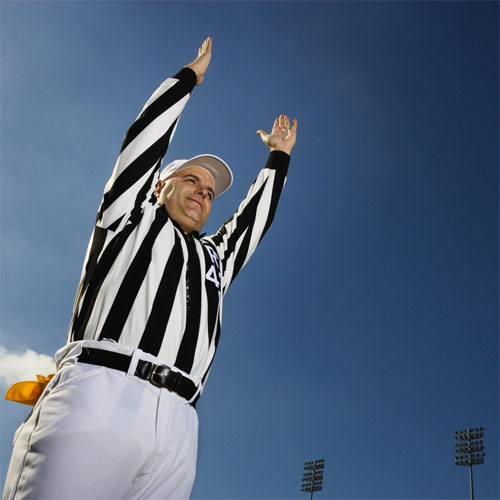
Zebra
Somewhere in, NJ
Male, 62
I've officiated football for over 30 years, now in my 26th on the college level. I've worked NCAA playoffs at the Division II and III level. In addition, I've coached at the scholastic level and have been an educator for over 35 years. I have no interest whatsoever in being an NFL official! Ever!
No but.... Receiver needs to catch the ball in the field of play or endzone and come to ground to complete the catch. If he lands in the endzone as maintains possession to complete the catch, then it is a TD.
It's a great, smart play by the receiving team. If the player is out of bounds and he touches the kick, then the kick is out of bounds. That is a free kick out of bounds and a foul by the kickers. One option on enforcement is placing the ball 25 yards in advance of the kick. Lions, 1st and 10.
I saw the play, heard Pereira. Wasn't quite sure what he meant. It can't be forward progress - which I think was still short - because Jordan on his own went backwards. Had he been hit and pushed back by the defender, then you have forward progress,
Didn't see this nor hear anything about it. You're saying it was "clearly back"; maybe not.
Tattoo Artist
 Is it illegal to tattoo a client if he's drunk?
Is it illegal to tattoo a client if he's drunk?
Poet
Rap Promoter / Manager
 Do rappers ever stage beefs with each other as a PR stunt?
Do rappers ever stage beefs with each other as a PR stunt?
That's a good question. Simply put, the tackler is responsible - period. And don't assume any whistle; as is often said, the play kills itself, not the whistle. For example, if a player is down and there's no immediate whistle, and the player gets hit, it's a foul, whistle or not.
Back to out of bounds: in your example A, you can envision the tackler right there as the runner hits OOB. You probably don't flag that because it's happening so quickly at the sideline. In B, you have a foul; that's pretty obvious. Cases in between? There really isn't an in-between. If the runner steps out, he's out and can't be hit. If the contact begins while the runner is in bounds, then it's not a foul unless there is unnecessary continuing contact out of bounds.
That is,a league/ team issue, not officiating.
No. If you accept the DH, then you go from the enforcement spot (previous spot ), Mark off 10vyards, repeat down.
-OR-
 Login with Facebook
Login with Facebook (max 20 characters - letters, numbers, and underscores only. Note that your username is private, and you have the option to choose an alias when asking questions or hosting a Q&A.)
(A valid e-mail address is required. Your e-mail will not be shared with anyone.)
(min 5 characters)
By checking this box, you acknowledge that you have read and agree to Jobstr.com’s Terms and Privacy Policy.
-OR-
 Register with Facebook
Register with Facebook(Don't worry: you'll be able to choose an alias when asking questions or hosting a Q&A.)